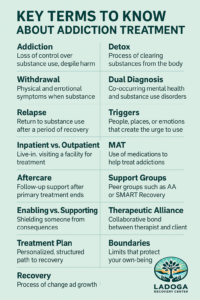When your child enters treatment for substance use, the language alone can feel like a foreign world. What’s the difference between inpatient and residential? What does “dual diagnosis” really mean? And why do you keep hearing words like “detox” and “relapse” with such heavy weight?
You’re not alone in feeling overwhelmed. At Ladoga Recovery Center, we believe education can ease fear—and understanding the terms used in addiction treatment is one way to feel more grounded, informed, and empowered to help.
This guide isn’t just about vocabulary. It’s about helping you walk this road with more confidence, compassion, and clarity.
1. Addiction
A chronic condition where a person loses control over their substance use, despite harm. It’s not a moral failing or lack of willpower—it’s a complex medical issue that affects the brain, body, and behavior.
“Addiction isn’t just about using drugs. It’s about what the person is using them to escape from.”
2. Detox
Short for “detoxification,” this is the initial process of clearing substances from the body, often with medical support. Detox is not the same as treatment—it’s the first step. Some people need inpatient detox to safely manage withdrawal symptoms.
3. Withdrawal
The physical and emotional symptoms that occur when someone stops using a substance their body has become dependent on. Symptoms can include nausea, shaking, anxiety, insomnia, and more—depending on the substance.
4. Dual Diagnosis (or Co-Occurring Disorders)
When someone experiences both a substance use disorder and a mental health condition (like depression, PTSD, or anxiety). Treatment works best when both are addressed together, not separately.
5. Relapse
When someone returns to substance use after a period of recovery. While painful, relapse is common and doesn’t erase progress. It’s a signal to adjust—not a sign of failure.

6. Triggers
People, places, emotions, or events that increase the urge to use substances. Learning to identify and cope with triggers is a core part of recovery. Some triggers are obvious; others are deeply emotional or unexpected.
7. Inpatient vs. Outpatient
- Inpatient (Residential): Live-in treatment with 24/7 care. Best for individuals who need stability and intensive support.
- Outpatient: Clients live at home and attend therapy or treatment sessions regularly. It allows for flexibility with work, school, or family responsibilities.
At Ladoga Recovery Center, we offer flexible outpatient programs designed for both structure and real-life integration. Learn more about our team and approach.
8. MAT (Medication-Assisted Treatment)
Use of FDA-approved medications (like Suboxone or Vivitrol) combined with counseling to treat addiction. MAT supports recovery by reducing cravings and withdrawal—and is especially helpful in opioid use disorder.
9. Cravings
Strong urges to use substances. These aren’t just “wants”—they can feel overwhelming, physical, and emotionally consuming. Learning healthy responses to cravings is part of relapse prevention.
10. Aftercare
The plan for ongoing support after formal treatment ends. This might include outpatient therapy, peer support groups, sober living, or alumni check-ins. Think of aftercare as a bridge, not a bonus.
11. Support Groups (12-Step or Not)
Groups like AA (Alcoholics Anonymous), NA (Narcotics Anonymous), or SMART Recovery offer peer connection and accountability. Not every group fits every person—but connection and community are crucial.
12. Enabling vs. Supporting
Enabling unintentionally shields someone from consequences (e.g., covering for missed work or bailing them out repeatedly).
Supporting means loving without rescuing—and sometimes letting natural consequences unfold.
13. Therapeutic Alliance
The bond between client and therapist. A strong alliance is one of the best predictors of success in treatment. If your child “clicks” with their therapist, that’s a powerful sign.
14. Treatment Plan
A personalized roadmap created by clinicians outlining recovery goals, therapeutic approaches, and measurable steps. It evolves over time and includes input from the individual in treatment.
15. Boundaries
Limits that protect your own well-being. For parents, boundaries might mean not checking your child’s phone, not giving money directly, or deciding when to say no. Boundaries help you stay whole while offering love.
16. Recovery
More than abstinence—it’s a process of healing, growth, and returning to a more connected, grounded version of self. Recovery is deeply personal and includes emotional, spiritual, and physical well-being.
FAQs: Understanding the Basics
What if I don’t understand a term the treatment team uses?
You can (and should) ask. No question is too small. A good provider will explain in plain language and make sure you feel informed.
Does relapse mean the treatment failed?
No. Relapse is often part of the recovery process. What matters is how it’s responded to and what can be learned from it.
Should I attend support groups as a parent?
Many families find support in groups like Al-Anon or Families Anonymous. These aren’t about fixing your child—they’re about caring for yourself.
Is outpatient treatment enough?
It can be. Many people succeed with outpatient programs, especially when there’s stability at home. Every person’s needs are different.
How do I know if my child’s program is working?
Look for signs like honest communication, small lifestyle changes, engagement in therapy, or even expressions of struggle. Progress doesn’t always look like perfection.
Ready to Take the Next Step?
You don’t have to memorize every term. You just have to care—and you already do. If you’re ready to talk with someone about what treatment could look like for your family, we’re here.
Call Ladoga Recovery Center at (844) 628-6202 or reach out online. We’ll walk this with you—at your pace, on your terms.

